Nowadays, we’ve managed to electrify a lot of the tools that used to be manual. Take a wheelchair, for example. Yes, many people who use a wheelchair still prefer to use the manual version. It provides a sense of autonomy, as well as an important way to get exercise. But there are also many reasons to choose a battery-powered wheelchair. For one thing, you may not be capable of operating a manual wheelchair. For another thing, you might want to transport groceries, or simply to have your hands free. And if you need to travel long distances, an electric wheelchair is also significantly faster.
Of course, to get the best performance, you want to have the best possible battery. For most modern electric wheelchairs, that means using a 12-volt, 7-amp-hour (Ah) sealed lead acid battery. Because these batteries are sealed, they’re safe to use in demanding conditions. That’s good news, since your battery needs to be able to travel wherever you go.
12-volt, 7Ah lead acid batteries are also used for a number of other applications. Most commonly, they can be found in fire and burglar alarm systems. They’re also used for universal power supplies, emergency lights, and some toy vehicles. But no matter what your application, you don’t want to use just any battery. You want a battery that’s going to last for years, not months. You also want one that can stand up to tough environmental conditions. The last thing you want is to get stranded because your wheelchair battery failed on a cold day. Finally, the battery needs to be small enough to fit in the battery well of your chair or other device.
To help you make the best decision, we’ve put together a list of the best 12-volt, 7Ah sealed lead acid batteries. We’ll begin by reviewing the Power Sonic. This is a rugged, durable battery that comes pre-charged for your convenience. Next, we’ll take a look at the ExpertPower. This is a more compact battery with equal power delivery. Finally, we’ll check out the Interstate Batteries Power Patrol. This is a reliable, heavy-duty battery that’s engineered specifically for safety-critical devices. Which one is going to be the right choice for you? Let’s take a closer look at each one of them, and see what they have to bring to the table!
Lead Acid Battery Basics
So, what makes one lead acid battery better than another? To start with, there are two broad categories of battery: starting (cold crank), and deep cycle. These batteries might even look similar, but they have two fundamentally different purposes. Starting batteries are designed to deliver large amounts of power in a short burst. A car battery is a good example. The battery needs to be able to operate at full power in order to turn the starter. That said, starting batteries perform poorly when they get drained. That’s why once a car battery has gone dead, it can suffer a permanent drop in performance.
Deep cycle batteries are the opposite. While they can’t deliver huge amounts of power at any one time, they have a lot more stamina. This means they can run for far longer, while delivering a slow, steady rate of power. These batteries are designed to be charged and fully discharged hundreds or thousands of times. Common applications for deep cycle batteries include wheelchairs, golf carts, and off-grid power backups. They’re also used for emergency lighting, alarm systems, and other devices that sometimes have to work without grid power. As a result, all of the batteries we’re reviewing today are deep cycle batteries.
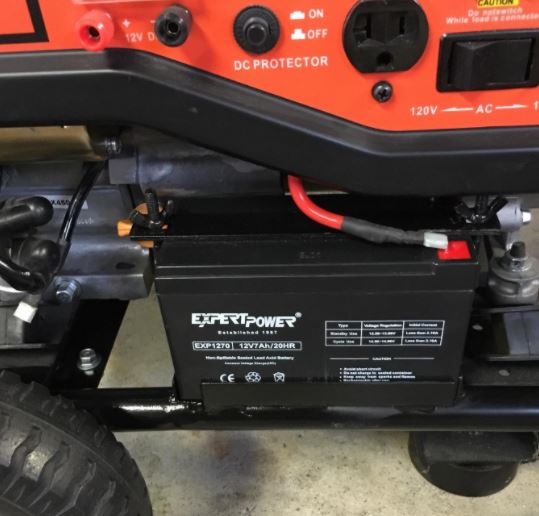
Lead Acid Battery Cells
Deep-cycle lead acid batteries use different types of technology to produce electricity. Nowadays, there are three main types: wet cell, absorbed glass mat (AGM), and gel. To understand how these batteries work, let’s take a look at each variety.
Wet cell batteries can either be sealed or serviceable. Both types are filled with acid and an electrolyte solution. However, the electrolyte solution can slowly dissipate over time. As water evaporates, the salinity rises, which impacts your performance. With a sealed battery, you’ll lose performance, whereas a serviceable battery can be topped off with water. Using a hygrometer, you can quickly achieve the correct equilibrium. Then again, serviceable batteries present a risk of spillage. There are many applications for this type of battery. That said, the safety risks make them undesirable for a lot of other applications.
AGM batteries work a little bit differently. Instead of the electrolyte solution floating in small tanks, it’s suspended in a fiberglass matting. This allows for far more efficiency, since the matting is wrapped around the lead plate. Since there’s more contact, the battery will deliver more power, and charge more quickly. AGM batteries aren’t just more efficient. They’re also safer. Because of the way the solution is suspended, there’s less risk of spillage. For this reason, as well as for their efficiency, they’re often used in performance applications. Among other uses, they’re used for power sports, solar battery banks, wheelchairs, and alarm systems.
That said, AGM batteries suffer a bit more than wet cell batteries when they’re deeply discharged. Ideally, you’ll want to avoid letting them go completely dead. But even if you’re getting a trickle of power, you’ll be able to recharge without doing damage.
Gel batteries are similar to AGM batteries in many respects. Most importantly, because the electrolyte isn’t a liquid, it cannot be spilled. This makes gel batteries suitable for similar high-demand applications to AGM batteries. That said, the electrolyte works a bit differently. Instead of being suspended in a fiberglass mat, it’s initially a liquid solution. However, silica is added to the liquid until it forms a sticky, viscous gel. This gel can then be used to enclose the solid plates, much like you could do with a fiberglass mat.
The main advantage of gel battery technology is that it can withstand exceptionally deep drains. If you intend to repeatedly drain your battery to near zero, this is a great feature. They also work well in extreme heat and cold, where other batteries can easily fail. Then again, gel batteries have their share of weaknesses. Primarily, this comes down to how sensitive they are. If you’re off by as little as two volts, you could overcharge your battery and damage the cell. As a result, you need to be very careful about the type of charger you use with this kind of battery.
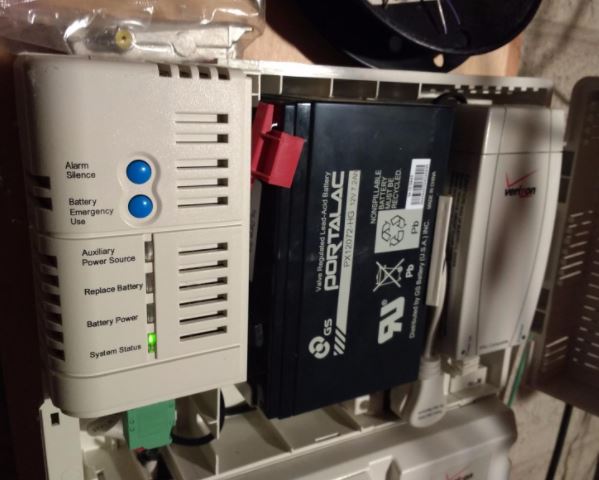
Both AGM and gel batteries are significantly more expensive than wet cells. For comparable size and performance, you can expect to pay about twice as much. That said, you get a lot of value. Not only these types of batteries safer, but they’re less prone to explosions. In addition, because they’re sealed, they tend to degrade far more slowly over time. For this reason, AGM and gel cell batteries will typically last much longer. In other words, you’re paying more for this type of battery up front. But down the road, you’ll be getting a far, far better value.
We’ve chosen to go with AGM batteries for a couple of reasons. For one thing, AGM batteries are the most versatile. You don’t have to worry about them being hyper-sensitive to their charging voltage. They’re extremely safe, as well. But the most important benefit of AGM batteries is that they tend to hold their charge the best. If you’re not always able to keep your battery on the charger, this is a great feature. It’s never fun when your battery fails simply because it went unattended. So for most purposes, an AGM battery is going to be your best choice.
One thing to keep in mind is that not all manufacturers call AGM batteries “AGM.” Gel cell batteries were actually invented first, and became the original standard for sealed batteries. As a result, a lot of people started calling all sealed batteries “gel batteries.” This is similar to the way people often say “google” when they’re referring to any kind of internet search. So even if the battery you’re replacing was marketed as a gel battery, take a closer look. There’s a good chance you were already using an AGM battery and didn’t even know it.
Along the same lines, not all manufacturers use the terms “AGM” or “absorbed glass mat.” Other common terms include “sealed regulated valve” (SRV), “non-spillable,” “valve-regulated,” “dry cell,” or “sealed lead acid” (SLA). Regardless of which one of these terms is used, you’re looking at an AGM battery.
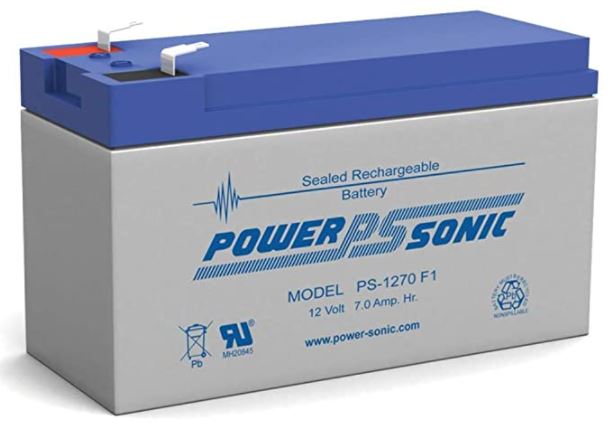
Power Sonic
The Power Sonic 12v, 7Ah battery has a wide, stocky design. The housing is grey on the bottom two thirds, and is quite sturdy. It certainly seems to be able to take a beating. The upper third of the housing is constructed from an even sturdier blue plastic. It’s advertised as shock-proof, and it seems to withstand shock and vibration very well. And if anything goes wrong, you’re protected by a 12-month manufacturer’s warranty. The overall dimensions are 5.95 inches wide, 2.56 inches deep, and 3.86 inches tall. This makes it easy to position in wider, narrower battery brackets. At 4.8 pounds, it’s also the heaviest battery on our list.
Like any AGM battery, the Power Sonic is rechargeable. It has a capacity of 7Ah, enough to work for over three hours under a 2-amp load. The battery even comes pre-charged. Then again, as with any pre-charged battery, it’s always wise to top it off before use. The contacts at the top end are an F1 variety, which is standard on most modern compatible equipment. That said, if you’re using older equipment, you’re liable to need a conversion kit.
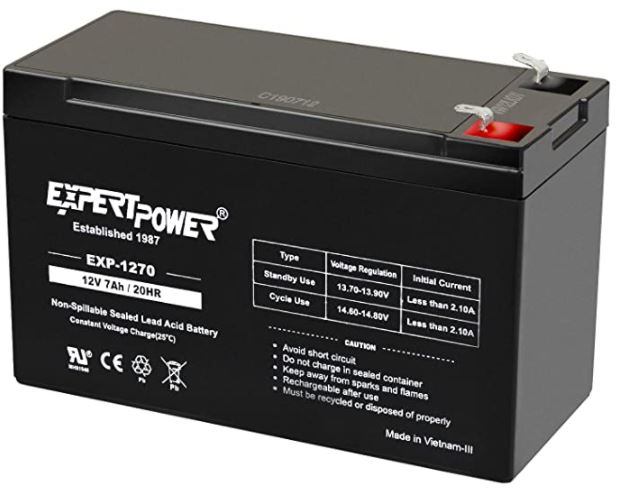
ExpertPower
ExpertPower is known for their high-quality batteries, such as their 12V deep cell LiFePO4 battery. The ExpertPower 12v, 7Ah sealed lead acid battery is available in a one- or a two-pack. It has an all-black housing, with F1 terminals on the top. One thing we appreciated is that you can get a free converter for older power systems. All you have to do is call ExpertPower with your order number, and they’ll send one to you.
The ExpertPower battery is slightly longer and narrower than the Power Sonic. It measures 6 inches in width, 2.5 inches in depth, and 3.7 inches in height. It’s also noticeably lighter, tipping the scales at a mere 4.3 pounds. Despite the lighter weight, it seems to be equally well-constructed. The ABS plastic case feels nice and sturdy, and stands up well to vibration. Like the Power Sonic battery, this one comes pre-charged, with a capacity of 7Ah.
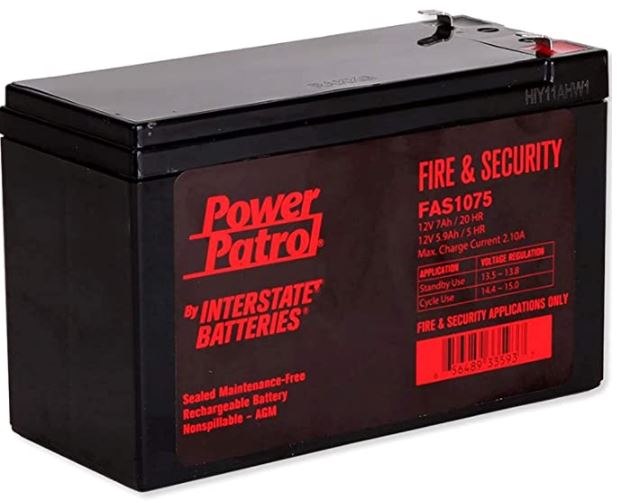
Interstate Batteries Power Patrol
The Interstate Batteries Power Patrol has a wider design, comparable to the Power Sonic battery. The width is only 5.94 inches, with a depth of 2.56 inches and a height of 3.7. And at 4.63 pounds in weight, this battery sits squarely in the middle of the other two. Like the others, it also sports a pair of F1 terminals on top of the black plastic housing. The housing itself seems very sturdy, and we didn’t have any concerns about shock or vibration. And if it does fail prematurely, you can take advantage of the 12-month warranty.
That said, the main attraction is on the inside. This is a very high-quality battery, engineered to have a very long shelf life. That’s an essential feature for many security and fire applications. In most cases, these systems have built-in chargers. But if your system doesn’t, you can count on the Power Patrol’s two-year shelf life. It doesn’t ship pre-charged, but charging takes only four hours. After that, you’re good to go!
Final Verdict
So, which of these batteries is the right choice for you? The Power Sonic battery comes reasonably well-equipped. It’s durable enough to take a beating, and it has a wider design with a heavier housing. The ExpertPower battery is a bit lighter, with a longer profile and lighter weight.
All three batteries provide comparable performance, so a lot comes down to price. If you just need a normal, functional battery, choose one of the first two options. That said, the Interstate Batteries Power Patrol offers superior standby performance. If you’re worried about shelf life, it’s the best of the bunch.
Meet Ry, “TechGuru,” a 36-year-old technology enthusiast with a deep passion for tech innovations. With extensive experience, he specializes in gaming hardware and software, and has expertise in gadgets, custom PCs, and audio.
Besides writing about tech and reviewing new products, he enjoys traveling, hiking, and photography. Committed to keeping up with the latest industry trends, he aims to guide readers in making informed tech decisions.

